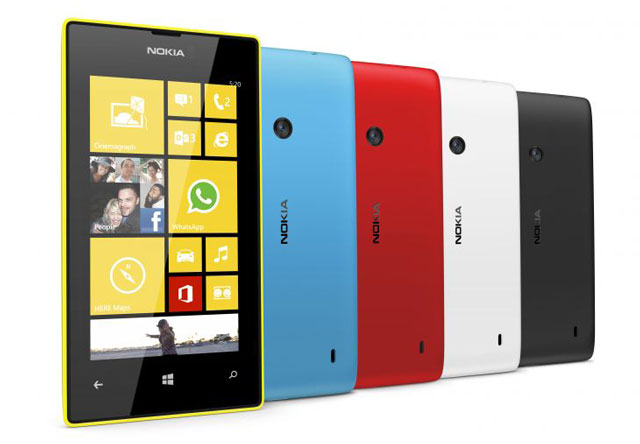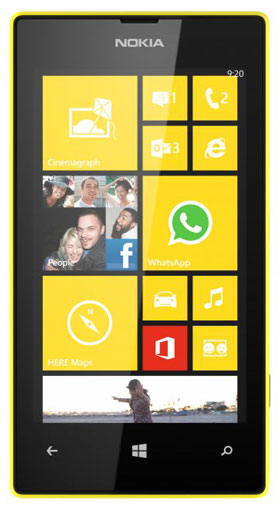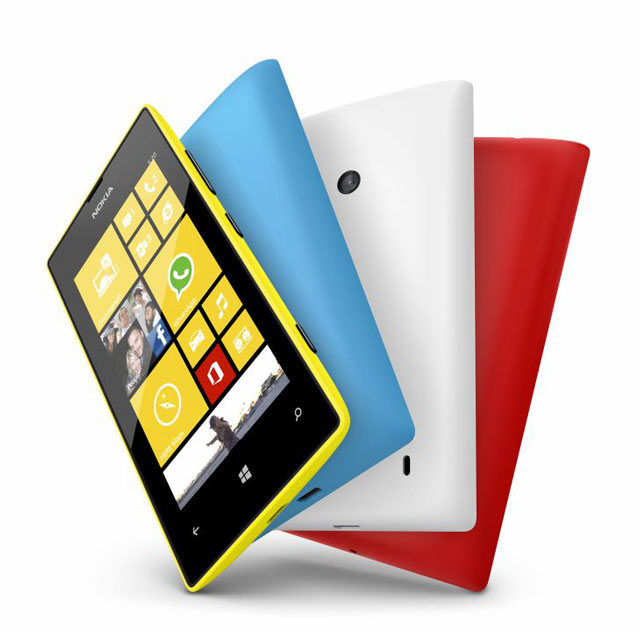
The Lumia 520 isn’t Nokia’s first budget Windows Phone device. There was the 620, with similar specifications. But the 520 is the most budget-friendly budget Lumia. So, just how much smartphone does R1 899 buy you? If the phone in question is the Lumia 520, the answer is rather a lot.
The fifth device in the Lumia range, the 520 is deceptively well-equipped given its price. It doesn’t really look like a sub-US$200 smartphone and, even in use, it behaves far more capably than the classification of “budget smartphone” suggests.
Weighing in at just 124g, the 520 feels great in hand, both on account of its dimensions — it’s a little thicker and a little wider than an iPhone 5 — and because of the tapered, matted rear cover.
 Like many Nokia handsets before it, the 520 has a removable rear cover with replacements available in a range of colours. The unit we reviewed was clad in a vibrant yellow with matching yellow interface theme making it stand out from rest of the review handsets littered around TechCentral’s offices. The 520 is also available in red, cyan, white and black, though you can be sure that palette will be expanded by third parties.
Like many Nokia handsets before it, the 520 has a removable rear cover with replacements available in a range of colours. The unit we reviewed was clad in a vibrant yellow with matching yellow interface theme making it stand out from rest of the review handsets littered around TechCentral’s offices. The 520 is also available in red, cyan, white and black, though you can be sure that palette will be expanded by third parties.
The face of the 520 is all black, apart from the Nokia logo above the 4-inch display and the three capacitive buttons — back, home and search — beneath it. Offering a resolution of 800×480 pixels, Nokia bills the 520’s touch display as “super sensitive”, meaning it can be operated while wearing gloves. That’s the sort of differentiating feature normally limited to top-end devices.
Nokia’s made other decisions that elevate the 520 above many of its peers. For a start, it includes 8GB of memory with the option to expand this by a further 64GB using the microSD slot beneath the rear cover. Then there’s the two-step dedicated shutter release button that allows users to half-press to focus and full-press to take a shot.
That’s not to say Nokia hasn’t cut costs with the 520. It clearly has. There’s no near-field communication chip, no digital compass, no front-facing camera, no LED flash for the rear camera, no 4G support, no HDMI port, and no support for wireless charging. However, for most users none of these omissions will matter.
Really, the only thing missing from the Lumia 520 that might disappoint some users is the lack of an FM radio, something that’s common on entry-level devices.
For most users who are in the market for an affordable smartphone, the Lumia 520 is more likely to impress with what it can do rather than disappoint with what it can’t. That seems to have been the idea. Rather than include shoddy instances of features, Nokia’s ditched those it deems unnecessary while ensuring the rest are sufficiently functional.
Take the 5-megapixel camera. It’s a little pedestrian — it doesn’t include a flash, a Carl Zeiss lens (a favourite of Nokia’s) or any PureView technology (Nokia’s high-end imaging system) — but it does take wholly acceptable images in good light and has responsive autofocus. Similarly, instead of shooting terrible 1080p video like some of its rivals, the 520’s camera captures average 720p video at 30 frames per second.
Despite “only” having a 1GHz dual-core processor and 512MB of RAM, the 520 is impressively resilient to lag. Flicking through menus and opening applications is speedy.

The 3G-powered Lumia has Wi-Fi, including the zippy 802.11n variant, and the ability to create a mobile hotspot. Really, it’s only power users who will find things to moan about on the 520, and odds are they’re planning to spend more anyway.
As it’s running Windows Phone 8, the 520 operates much like its more expensive Lumia siblings and this means many of the same benefits and failings (mainly an app ecosystem that is not as rich as it is on the Apple and Google platforms).
Nevertheless, the catalogue is improving. WhatsApp, Viber, Tumblr, Skype (which Microsoft owns), and applications for social networking are all covered. Nokia’s own apps, including Nokia Music, Mix Radio, Here Maps and Drive, are all excellent, and come standard with the 520.
Beneath the removable rear cover lies a 1 430mAh battery. That may not sound like much when compared to the latest large-screen Android-powered smartphones, but then the 520 doesn’t have as many pixels to illuminate or as much hardware to power. The 520 should last a fairly frantic working day. And the battery is removable, so snapping in a fully charged one is no sweat.
If asked to recommend a budget smartphone, the Lumia 520 would most likely feature near the top our list. The features it’s missing are understandable concessions and the decision to ensure those that are included aren’t merely token makes it an extremely capable device at a great price. We think Nokia has a real winner on its hands here. — (c) 2013 NewsCentral Media




